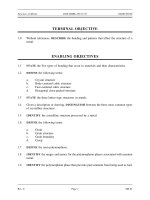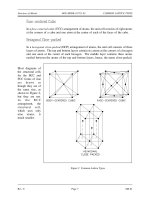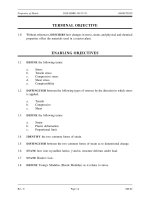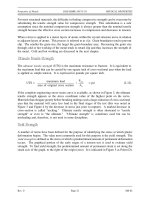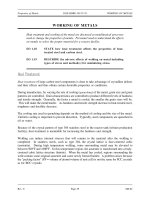Material Science_ Vol 1 of 2 - US DOE (1993) WW Part 11 ppsx
Bạn đang xem bản rút gọn của tài liệu. Xem và tải ngay bản đầy đủ của tài liệu tại đây (95.75 KB, 8 trang )
Properties of Metals DOE-HDBK-1017/1-93 WORKING OF METALS
WORKING OF METALS
Heat treatment and working of the metal are discussed as metallurgical processes
used to change the properties of metals. Personnel need to understand the effects
on metals to select the proper material for a reactor facility.
EO 1.18 STATE how heat treatment affects the properties of heat-
treated steel and carbon steel.
EO 1.19 DESCRIBE the adverse effects of welding on metal including
types of stress and method(s) for minimizing stress.
Heat treatment of large carbon steel components is done to take advantage of crystalline defects
and their effects and thus obtain certain desirable properties or conditions.
During manufacture, by varying the rate of cooling (quenching) of the metal, grain size and grain
patterns are controlled. Grain characteristics are controlled to produce different levels of hardness
and tensile strength. Generally, the faster a metal is cooled, the smaller the grain sizes will be.
This will make the metal harder. As hardness and tensile strength increase in heat-treated steel,
toughness and ductility decrease.
The cooling rate used in quenching depends on the method of cooling and the size of the metal.
Uniform cooling is important to prevent distortion. Typically, steel components are quenched in
oil or water.
Because of the crystal pattern of type 304 stainless steel in the reactor tank (tritium production
facility), heat treatment is unsuitable for increasing the hardness and strength.
Welding can induce internal stresses that will remain in the material after the welding is
completed. In stainless steels, such as type 304, the crystal lattice is face-centered cubic
(austenite). During high temperature welding, some surrounding metal may be elevated to
between 500°F and 1000°F. In this temperature region, the austenite is transformed into a body-
centered cubic lattice structure (bainite). When the metal has cooled, regions surrounding the
weld contain some original austenite and some newly formed bainite. A problem arises because
the "packing factor" (PF = volume of atoms/volume of unit cell) is not the same for FCC crystals
as for BCC crystals.
Rev. 0 Page 29 MS-02
WORKING OF METALS DOE-HDBK-1017/1-93 Properties of Metals
The bainite that has been formed occupies more space than the original austenite lattice. This
elongation of the material causes residual compressive and tensile stresses in the material.
Welding stresses can be minimized by using heat sink welding, which results in lower metal
temperatures, and by annealing.
Annealing is another common heat treating process for carbon steel components. During
annealing, the component is heated slowly to an elevated temperature and held there for a long
period of time, then cooled. The annealing process is done to obtain the following effects.
a. to soften the steel and improve ductility
b. to relieve internal stresses caused by previous processes such as heat treatment,
welding, or machining
c. to refine the grain structure
Plastic deformation which is carried out in a temperature region and over a time interval such that
the strain hardening is not relieved is called cold work. Considerable knowledge on the structure
of the cold-worked state has been obtained. In the early stages of plastic deformation, slip is
essentially on primary glide planes and the dislocations form coplanar arrays. As deformation
proceeds, cross slip takes place. The cold-worked structure forms high dislocation density regions
that soon develop into networks. The grain size decreases with strain at low deformation but
soon reaches a fixed size. Cold working will decrease ductility.
Hot working refers to the process where metals are deformed above their recrystallization
temperature and strain hardening does not occur. Hot working is usually performed at elevated
temperatures. Lead, however, is hot-worked at room temperature because of its low melting
temperature. At the other extreme, molybdenum is cold-worked when deformed even at red heat
because of its high recrystallization temperature.
The resistance of metals to plastic deformation generally falls with temperature. For this reason,
larger massive sections are always worked hot by forging, rolling, or extrusion. Metals display
distinctly viscous characteristics at sufficiently high temperatures, and their resistance to flow
increases at high forming rates. This occurs not only because it is a characteristic of viscous
substances, but because the rate of recrystallization may not be fast enough.
MS-02 Page 30 Rev. 0
Properties of Metals DOE-HDBK-1017/1-93 WORKING OF METALS
The important information in this chapter is summarized below.
Quenching
Varying the rate of cooling (quenching) of the metal controls grain
size and grain patterns.
Grain characteristics are controlled to produce different levels of
hardness and tensile strength.
Hardness and tensile strength increase in heat-treated steel;
toughness and ductility decrease.
Welding
Produces compressive and tensile stresses
Stresses are minimized by using heat sink welding and annealing
Annealing
Softens steel and improves ductility
Relieves internal stresses caused by previous processes
Refines grain structure
Rev. 0 Page 31 MS-02
CORROSION DOE-HDBK-1017/1-93 Properties of Metals
CORROSION
Corrosion is a major factor in the selection of material for a reactor plant. The
material selected must resist the various types of corrosion discussed in the
Chemistry Fundamentals Handbook.
EO 1.20 STATE the reason that galvanic corrosion is a concern in
design and material selection.
Corrosion is the deterioration of a material due to interaction with its environment. It is the
process in which metallic atoms leave the metal or form compounds in the presence of water and
gases. Metal atoms are removed from a structural element until it fails, or oxides build up inside
a pipe until it is plugged. All metals and alloys are subject to corrosion. Even the noble metals,
such as gold, are subject to corrosive attack in some environments.
The corrosion of metals is a natural process. Most metals are not thermodynamically stable in
the metallic form; they want to corrode and revert to the more stable forms that are normally
found in ores, such as oxides. Corrosion is of primary concern in nuclear reactor plants.
Corrosion occurs continuously throughout the reactor plant, and every metal is subject to it. Even
though this corrosion cannot be eliminated, it can be controlled.
General corrosion involving water and steel generally results from chemical action where the
steel surface oxidizes, forming iron oxide (rust). Many of the systems and components in the
plant are made from iron.
Some standard methods associated with material selection that protect against general corrosion
include:
The use of corrosion-resistant materials such as stainless steel and nickel,
chromium, and molybdenum alloys. (Keep in mind that the corrosion is
electrochemical by nature, and the corrosion resistance of the stainless steels
results from surface oxide films that interfere with the electrochemical process.)
The use of protective coatings such as paints and epoxies.
The application of metallic and nonmetallic coatings or linings to the surface
which protects against corrosion, but allows the material to retain its structural
strength (for example, a carbon steel pressure vessel with stainless steel cladding
as a liner).
MS-02 Page 32 Rev. 0
Properties of Metals DOE-HDBK-1017/1-93 CORROSION
Galvanic corrosion occurs when two dissimilar metals with different potentials are placed in
electrical contact in an electrolyte. It may also take place with one metal with heterogeneities
(dissimilarities) (for example, impurity inclusions, grains of different sizes, difference in
composition of grains, or differences in mechanical stress). A difference in electrical potential
exists between the different metals and serves as the driving force for electrical current flow
through the corrodant or electrolyte. This current results in corrosion of one of the metals. The
larger the potential difference, the greater the probability of galvanic corrosion. Galvanic
corrosion only causes deterioration of one of the metals. The less resistant, more active one
becomes the anodic (negative) corrosion site. The stronger, more noble one is cathodic (positive)
and protected. If there were no electrical contact, the two metals would be uniformly attacked
by the corrosive medium. This would then be called general corrosion.
For any particular medium, a list can be made arranging metals sequentially from most active,
or least noble, to passive, or most noble. The galvanic series for sea water is discussed in the
Chemistry Fundamentals Handbook.
Galvanic corrosion is of particular concern in design and material selection. Material selection
is important because different metals come into contact with each other and may form galvanic
cells. Design is important to minimize differing flow conditions and resultant areas of corrosion
buildup. Loose corrosion products are important because they can be transported to the reactor
core and irradiated.
In some instances, galvanic corrosion can be helpful in the plant. For example, if pieces of zinc
are attached to the bottom of a steel water tank, the zinc will become the anode, and it will
corrode. The steel in the tank becomes the cathode, and it will not be effected by the corrosion.
This technique is known as cathodic protection. The metal to be protected is forced to become
a cathode, and it will corrode at a much slower rate than the other metal, which is used as a
sacrificial anode.
Localized corrosion is defined as the selective removal of metal by corrosion at small areas or
zones on a metal surface in contact with a corrosive environment, usually a liquid. It usually
takes place when small local sites are attacked at a much higher rate than the rest of the original
surface. Localized corrosion takes place when corrosion works with other destructive processes
such as stress, fatigue, erosion, and other forms of chemical attack. Localized corrosion
mechanisms can cause more damage than any one of those destructive processes individually.
There are many different types of localized corrosion. Pitting, stress corrosion cracking, chloride
stress corrosion, caustic stress corrosion, primary side stress corrosion, heat exchanger tube
denting, wastage, and intergranular attack corrosion are discussed in detail in the Chemistry
Fundamentals Handbook.
Rev. 0 Page 33 MS-02
CORROSION DOE-HDBK-1017/1-93 Properties of Metals
One of the most serious metallurgical problems and one that is a major concern in the
nuclear industry is stress-corrosion cracking (SCC). SCC is a type of intergranular attack
corrosion that occurs at the grain boundaries under tensile stress. It tends to propagate
as stress opens cracks that are subject to corrosion, which are then corroded further,
weakening the metal by further cracking. The cracks can follow intergranular or
transgranular paths, and there is often a tendency for crack branching.
The cracks form and propagate approximately at right angles to the direction of the tensile
stresses at stress levels much lower than those required to fracture the material in the
absence of the corrosive environment. As cracking penetrates further into the material,
it eventually reduces the supporting cross section of the material to the point of structural
failure from overload.
Stresses that cause cracking arise from residual cold work, welding, grinding, thermal
treatment, or may be externally applied during service and, to be effective, must be tensile
(as opposed to compressive).
SCC occurs in metals exposed to an environment where, if the stress was not present or
was at much lower levels, there would be no damage. If the structure, subject to the same
stresses, were in a different environment (noncorrosive for that material), there would be
no failure. Examples of SCC in the nuclear industry are cracks in stainless steel piping
systems and stainless steel valve stems.
The most effective means of preventing SCC in reactor systems are: 1) designing
properly; 2) reducing stress; 3) removing critical environmental species such as
hydroxides, chlorides, and oxygen; 4) and avoiding stagnant areas and crevices in heat
exchangers where chloride and hydroxide might become concentrated. Low alloy steels
are less susceptible than high alloy steels, but they are subject to SCC in water containing
chloride ions. Nickel-based alloys, however, are not effected by chloride or hydroxide
ions.
An example of a nickel-based alloy that is resistant to stress-corrosion cracking is inconel.
Inconel is composed of 72% nickel, 14-17% chromium, 6-10% iron, and small amounts
of manganese, carbon, and copper.
One of the most important forms of stress corrosion that concerns the nuclear industry is
chloride stress corrosion. Chloride stress corrosion is a type of intergranular corrosion
and occurs in austenitic stainless steel under tensile stress in the presence of oxygen,
chloride ions, and high temperature.
MS-02 Page 34 Rev. 0
Properties of Metals DOE-HDBK-1017/1-93 CORROSION
It is thought to start with chromium carbide deposits along grain boundaries that leave the
metal open to corrosion. This form of corrosion is controlled by maintaining low chloride
ion and oxygen content in the environment and use of low carbon steels.
Despite the extensive qualification of inconel for specific applications, a number of
corrosion problems have arisen with inconel tubing. Improved resistance to caustic stress
corrosion cracking can be given to inconel by heat treating it at 620°C to 705°C,
depending upon prior solution treating temperature. Other problems that have been
observed with inconel include wastage, tube denting, pitting, and intergranular attack.
Rev. 0 Page 35 MS-02
CORROSION DOE-HDBK-1017/1-93 Properties of Metals
The important information in this chapter is summarized below.
Corrosion is the natural deterioration of a metal in which metallic atoms leave the
metal or form compounds in the presence of water or gases. General corrosion
may be minimized by the use of corrosion-resistant materials and the addition of
protective coatings and liners.
Galvanic corrosion occurs when dissimilar metals exist at different electrical
potentials in the presence of an electrolyte. Galvanic corrosion may be reduced
by the careful design and selection of materials regarding dissimilar metals and the
use of sacrificial anodes.
Localized corrosion can be especially damaging in the presence of other
destructive forces such as stress, fatigue, and other forms of chemical attack.
Stress-corrosion cracking occurs at grain boundaries under tensile stress. It
propagates as stress opens cracks that are subject to corrosion, ultimately
weakening the metal until failure. Effective means of reducing SCC are 1) proper
design, 2) reducing stress, 3) removing corrosive agents, and 4) avoiding areas of
chloride and hydroxide ion concentration.
Chloride stress corrosion occurs in austinitic stainless steels under tensile stress
in the presence of oxygen, chloride ions, and high temperature. It is controlled by
the removal of oxygen and chloride ions in the environment and the use of low
carbon steels.
Problems occurring with the use of inconel include caustic stress corrosion
cracking, wastage, tube denting, pitting and intergranular attack. Inconel's
resistance to caustic stress corrosion cracking may be improved by heat treating.
MS-02 Page 36 Rev. 0


